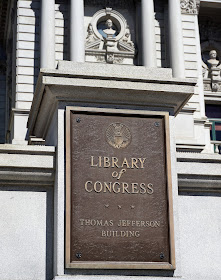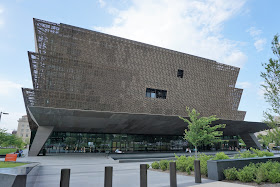Just across the street from the U.S. Capitol is a building whose name I've always been familiar with, but which I knew little to nothing about: the Library of Congress.
 |
| U.S. Capitol as seen from the steps of the Library |
 |
| The main building of the Library of Congress |
The Library has an interesting history of stops and starts:
1783: James Madison suggests creating a congressional library.
1800: The Library of Congress is signed into existence by President John Adams when the capital moves from New York to Washington, D.C. A total of 740 books and 3 maps ordered from Europe constitute the first collection, which is housed in the capitol building and is meant to service the reference needs of Congress.
1814: Invading British troops destroy the Library of Congress and its collection, which has grown to 3,000 volumes. Thomas Jefferson almost immediately offers to sell Congress his personal library as the base for a new collection. (Why didn't he just give it to them?)
1815: Congress designates $23,950 to purchase his 6,487 books. ($3.69/book is a pretty good deal for Jefferson in 1815.) The library continues to grow.
1851: A disastrous fire destroys 35,000 of the library's 60,000 or so books, among which are two-thirds of Jefferson's collection. Congress replaces the number of lost books.
1865: By the end of the Civil War, there are about 80,000 volumes in the library. The next decade sees tremendous growth, both in the number of books in the library and in the power of the organization itself when the library is given jurisdiction over all copyright registration.
1876: The Library of Congress has over 300,000 volumes and begins construction of the present main library building.
1897: With a collection of over 840,000 volumes, the Library moves into the Beaux Arts style Thomas Jefferson Building.











































